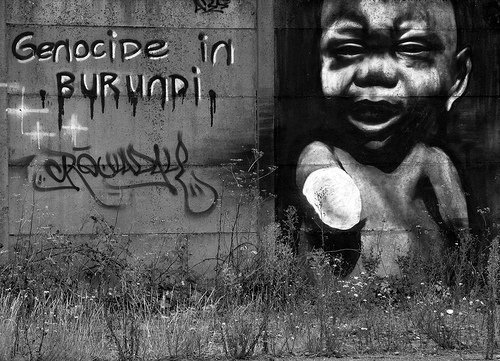Burundian genocides (1972)
Hey Steemians, in this article I'm gonna write short story about genocides in Burundi.
Today, estimates hover in between these two figures, at between 80,000 and 210,000 killed.To indicate the scale of the drama you should know, that in 1972 Burundi was a country of 3.5 milion people. So in this civil war died more than 1/25 civils.

First of all, we should find out where Burundi is.
is a landlocked country in the African Great Lakes region of East Africa, bordered by Rwanda to the north, Tanzania to the east and south, and the Democratic Republic of the Congo to the west. It is also considered part of Central Africa. Burundi's capital is Bujumbura. The southwestern border is adjacent to Lake Tanganyika.
Probably you heard something about Tutsi & Hutu, because of Rwandan genocides. Yes, in Burundi it were also war between Tutsi and Hutu. It was 1972 when the Hutu people began to kill Tutsi nation. So everything happened before the genocide in Rwanda.
You should know, that in past time Burundi was a united kingdom with three main ethnic groups - the Twa (1%), the Tutsi (15%) and the Hutu (84%). Try to imagine 1972 year. Burundi is very small and poor country. Only one thing you can see is poverty. These three ethnic groups shared a language called Kirundi and shared customs and habits. Similar people from other etnic groups and genocide? Looks crazy, right?
Because of I'd like to write short story, I skip part of a political background. One more important fact for this story is that Burundi was a colony of Belgium. They left Burundi in 1962.
In 1971, there was a split within Burundi’s military regime. President Micombero, a Tutsi of the Hima clan, appointed members of his clan to his government and senior military positions and removed Tutsi from the Banyaruguru clan. In July 1971, Banyaruguru clan members were accused of plotting a coup by Hima elements, but they never even attempted to pull it off. A military court ordered the execution of nine senior officers and life imprisonment for another 11 officers, all Banyaruguru. The military regime was weaker than ever and increased its use of violence. On April 29, 1972, a group of Hutu rebels organized in the Tanzania, (most members were born in the Tanzania), took control of the city of Rumonge in western Burundi. On the same day, the gang instructed Hutu in the area to murder the Tutsi. Witnesses reported many massacres. In the nearby town of Bururi, all Tutsi soldiers, civilians and representatives of the Tutsi authorities were murdered. After the locals gained control of a 70km strip on the shore of Lake Tanganyika in western Burundi, from Rumonge to Nyanza Lac in the southwest, they declared that they would kill all Tutsi and any Hutu who did not join them. This area was declared an independent Republic of Martyazo and was controlled by the extremist Hutu militia. At most, a few thousand Hutu (most of them from the Congo) participated in the rebellion, and approximately one thousand Tutsi were killed. In June 1972, during the height of the genocide, the soon-to-be Tutsi government of Burundi claimed that 25,000 Hutu participated in the rebellion and that 50,000 Tutsi were killed.King of Burundi have decided to back to Burundi. He was on emigration in German Federal Republic. He returned from six years of exile in Europe, one night before the rebellion broke out. Same night he was killed, on the president's orders. Micombero, who was a president of this country disbanded his government and increased his own authority. This is how preparations for genocide looked.
The next day, after King murdered (April 30), group of senior officers of Hima-Tutsi origin, known to be close to the president began planning extermination of all of Hutu. The Hutu rebellion was ended in early May. From the moment that it ended, the organized extermination of Hutu began.
By the end of August, more than 200,000 people had been reported killed and hundreds of thousands more had fled to neighboring countries — no educated Hutu remained.

Of course it's not full story, but if you want to collect more knowledge look below, there is a source-link. If you take look on 1994 year and genocide in Rwanda you can have only one conclusion:
history repeats itselfThat's why I'm writing this short story, maybe with spelling errors (cuz my english is not enough good to be fluent speaker), we can't make this bullshit (look below) true again:
A single death is a tragedy; a million deaths is a statistic.